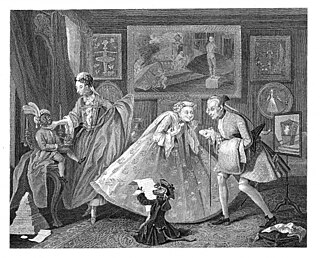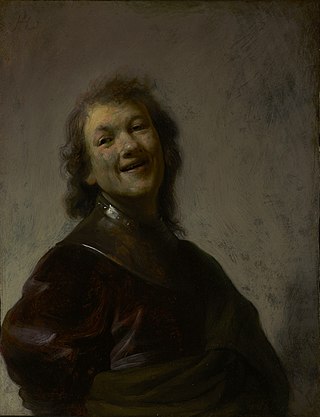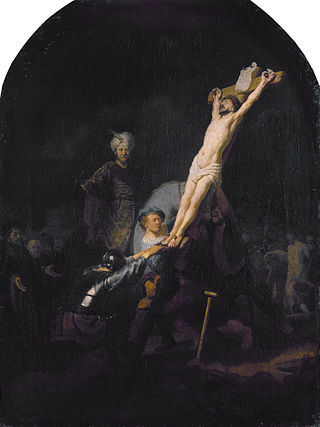
Portrait of Baldassare Castiglione is a c. 1514–1515 oil painting attributed to the Italian High Renaissance painter Raphael. Considered one of the great portraits of the Renaissance, it has an enduring influence. It depicts Raphael's friend, the diplomat and humanist Baldassare Castiglione, who is considered a quintessential example of the High Renaissance gentleman.

Dirck Jansz Pesser was a Dutch brewer from Rotterdam, best known today for his portrait by Rembrandt. He was an important member of the Rotterdam Remonstrant community in the early 17th century.
Religious clothing is clothing which is worn in accordance with religious practice, tradition or significance to a faith group. It includes clerical clothing such as cassocks, and religious habit, robes, and other vestments. Accessories include hats, wedding rings, crucifixes, etc.

Taste in High Life is an oil-on-canvas painting from around 1742, by William Hogarth. The version seen on the right was engraved by Samuel Phillips in 1798, under commission from John Boydell for a posthumous edition of Hogarth's works, but Phillips's final, third state was not published until 1808.

The Hundred Guilder Print is an etching by Rembrandt. The etching's popular name derives from the large sum of money supposedly once paid for an example. It is also called Christ healing the sick, Christ with the Sick around Him, Receiving Little Children, or Christ preaching, since the print depicts multiple events from Matthew 19 in the New Testament, including Christ healing the sick, debating with scholars and calling on children to come to him. The rich young man mentioned in the chapter is leaving through the gateway on the right.

Marriage Portrait of Isaac Massa and Beatrix van der Laen is a painting by the Dutch Golden Age painter Frans Hals, painted c. 1622 and now in the Rijksmuseum, Amsterdam. The couple has been identified as Isaac Massa and his bride Beatrix van der Laen.

The Fountain of Life or The Fountain of Grace and the Triumph of the Church over the Synagogue are names given to an oil on panel painting completed c 1432. For most of its history the painting has been in Spain, latterly in the Museo del Prado which recently featured it in a special exhibition. Stylistically and thematically, the painting is related to the work of Jan van Eyck, but it is unsigned and there have been competing theories as to whether it is by van Eyck himself.

History of clothing in the Indian subcontinent can be traced to the Indus Valley civilization or earlier. Indians have mainly worn clothing made up of locally grown cotton. India was one of the first places where cotton was cultivated and used even as early as 2500 BCE during the Harappan era. The remnants of the ancient Indian clothing can be found in the figurines discovered from the sites near the Indus Valley civilisation, the rock-cut sculptures, the cave paintings, and human art forms found in temples and monuments. These scriptures view the figures of human wearing clothes which can be wrapped around the body. Taking the instances of the sari to that of turban and the dhoti, the traditional Indian wears were mostly tied around the body in various ways.

Mughal clothing refers to clothing adhered by the Mughals in the 16th, 17th and 18th centuries throughout the extent of their empire. Much of them were already being used in the past centuries before their arrival in Indian subcontinent. It was characterized by luxurious styles and was made with muslin, silk, velvet and brocade. Elaborate patterns including dots, checks, and waves were used with colors from various dyes including cochineal, sulfate of iron, sulfate of copper and sulfate of antimony were used.

Walk on the beach is a 1909 oil-on-canvas painting by the Spanish painter Joaquín Sorolla.

The Girl in a Picture Frame is a 1641 oil on panel painting by the Dutch artist Rembrandt. It is also known as The Jewish Bride and The Girl in a Hat. With The Scholar at the Lectern and Landscape with the Good Samaritan, it is one of three Rembrandt paintings in Polish collections. It is currently located at the Royal Castle in Warsaw.

Portrait of a Man, probably a Member of the Van Beresteyn Family is an oil-on-canvas 1632 portrait painting by Rembrandt. It shows a man with a lace collar, which was a new fashion in the 1630s replacing older-styled millstone collars. It is pendant to Portrait of a Woman, probably a Member of the Van Beresteyn Family, and both are in the collection of the Metropolitan Museum of Art.

Portrait of a Young Woman with a Fan is a 1633 portrait painting by Rembrandt. It shows a woman holding a fan, pendant to Portrait of a Man Rising from His Chair. It is in the collection of the Metropolitan Museum of Art.

Family Group in a Landscape is an oil-on-canvas painting by the Dutch Golden Age painter Frans Hals, painted c. 1645-1648, and now in the Museo Thyssen-Bornemisza, in Madrid.

Saint Anthony Preaching to the Fish is a 1580–1585 oil-on-canvas painting of Anthony of Padua by Paolo Veronese, now in the Galleria Borghese in Rome. Its original location is unknown, though its medium dimensions of 104 centimetres (41 in) by 150 centimetres (59 in) mean it may have been painted for the side wall of a chapel or as part of a cycle of paintings for a small school (scuola) somewhere in Veneto. It entered the collection of Cardinal Scipione Borghese as a 1607 gift from Francesco Barbaro.

Saint John the Baptist Preaching is a 1562 oil-on-canvas painting of John the Baptist by Paolo Veronese, now in the Galleria Borghese in Rome. The painting depicts John the Baptist acting primarily and quite literally as a messenger for the coming of Jesus.

Rembrandt Laughing is a c. 1628 oil on copper painting by the Dutch painter Rembrandt van Rijn. It is an elaborate study of a laughing face, a tronie, and, since it represents the painter himself, one of over 40 self-portraits by Rembrandt, probably the earliest elaborate one. The painting, which was only recently discovered, is now in the J. Paul Getty Museum, California.

Leaf from a Manichaean book MIK III 4959 is a fragment of Manichaean manuscripts collected in Germany Berlin Asian Art Museum, drawn during the 8th-9th centuries, Was discovered in Xinjiang by German Turpan expedition team in the early 20th century. The remaining page is 8.2 cm long and 11.0 cm wide, with slender painting illustrations on both sides.

The Ecce Homo is a large oil painting by Titian, signed and dated 1543, which hangs in the Kunsthistorisches Museum in Vienna. It is not to be confused with several smaller compositions by Titian.

Raising of the Cross is a 1633 painting by the Dutch Golden Age painter Rembrandt in the collection of the Alte Pinakothek. It was painted as part of a "passion" series commissioned in 1633 by Frederick Henry, Prince of Orange. Together with its pendant, The Descent from the Cross, it is one of the rare paintings by Rembrandt with a continuous provenance from the date of completion to today.



















